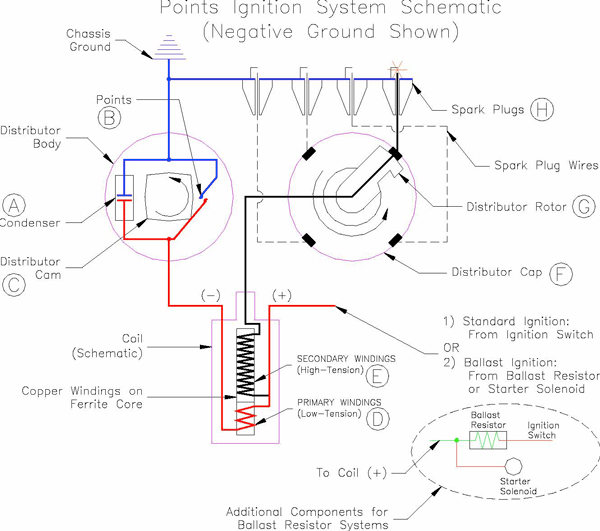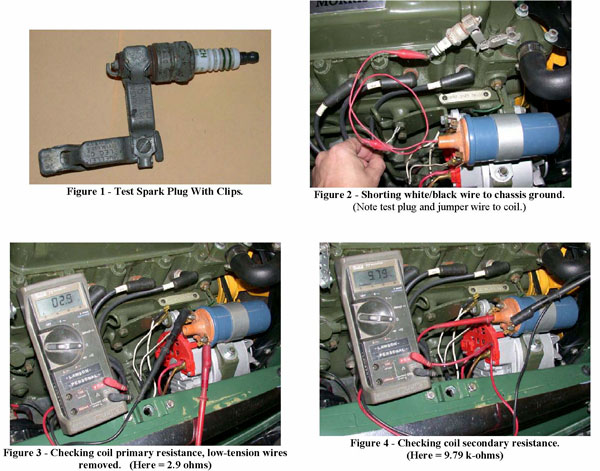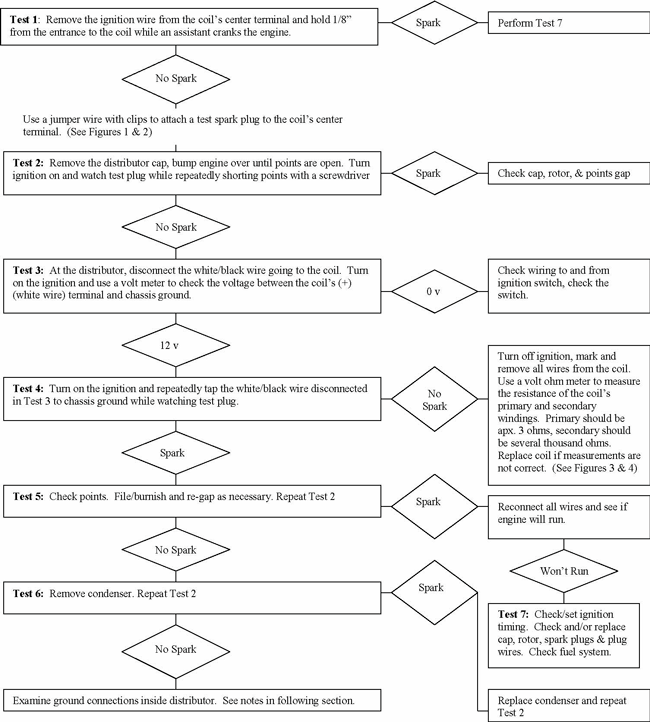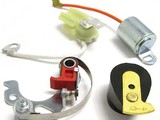| Troubleshooting Lucas Points Ignition Systems | Rev.02 |
| Doug Lawson ( [email protected] ) | July, 2006 |
| What is Covered: |
The following document discusses the operation of the basic “points type” ignition system. Included are steps to troubleshoot the ignition system. This document presents a negative ground system only. Please read the Theory of Operation section before attempting to troubleshoot your ignition system.
What is Not Covered:
Symptoms of ignition system failure are not presented. Ballasted ignition coil systems are briefly discussed in the closing. Steps to troubleshoot the ballast ignitions are not presented here.
Glossary:
(Refer to the following schematic)
A: Condenser. This is a capacitor wired in parallel to the points. It absorbs energy when the points open to prevent their pitting and burning.
B: Points. The points act as a switch, connecting the coil’s (-) terminal to chassis ground.
C: Distributor Cam. This multi-lobed spline rotates at 1/2 engine speed. High spots on the cam open and close the points
D & E: Coil. The coil operates as a transformer, boosting battery potential (on the primary or low-tension side “D”) to several thousand volts (on the secondary or high-tension side “E”).
F: Distributor Cap. The distributor cap serves as a distribution center. High-voltage developed by the coil is delivered to the appropriate spark plug according to the position of the rotor “G” inside the distributor cap.
G: Distributor Rotor. This is a moving contact attached to the top of the distributor cam. High-voltage from the coil enters the center of the distributor cap and is routed along the rotor to its tip. As the distributor cam rotates it moves the rotor inside the cap to align with contacts inside the distributor cap.
H: Spark Plugs. The spark plugs are connected to the distributor cap by the spark plug wires. High-voltage travels down these wires and passes through the center insulator of the spark plug. Inside the combustion chamber, this energy jumps an air gap between the center electrode and the shell of the spark plug. The spark plug shell is grounded when threaded into the combustion chamber. High-voltage jumping this air gap produces a spark to ignite the fuel air mixture in the combustion chamber.
Successfully troubleshooting engine problems comes with experience and familiarity with the theories of operation for the fuel and ignition systems. Total ignition system failure results in the sudden and complete shutdown of an engine. Poorly adjusted or worn ignition system components can result in engines that are hard to start, misfire at speed, or suffer from poor drivability. Seemingly unrelated factors such as high relative humidity or rain can exacerbate these problems. Fuel problems typically cause a slow and sputtering shutdown of an engine or its inability to achieve full power or speed. Methodically testing the basic system components while duplicating (where possible) the situations under which the problems occur will generally result in the source of the problem being identified. There are not many parts to go wrong in a points system so troubleshooting is a process of following the voltage through the circuit. If a spark is present and occurs at the correct time the fuel system is suspect.

Ignition System Schematic
Theory of Operation:
In the discussions that follow, all electrical polarity mentioned is for negative ground cars.
Points ignition systems consist of high-and low-tension circuits. The low-tension circuit operates at battery voltage, the high-tension circuit provides the energy to produce a spark in the combustion chamber to ignite the fuel/air mixture. The low-tension circuit includes the ignition switch, points, condenser, and coil while the high-tension circuit includes the coil, distributor cap & rotor, spark plugs and spark plug wires. The low-and high-tension circuits meet inside the coil which acts as a transformer, stepping up battery potential to several thousand volts.
When the ignition key is turned to the “on” or “run” position, battery voltage from the switch is supplied to the coil’s (+) terminal. One side of the points inside the distributor are connected to the coil’s (-) terminal, the other side is connected to chassis ground. When the points are closed (contacts touching), the points provide a path to ground for electric current passing through the coil from the ignition switch. This current flows through the primary or low-tension side of the coil.
The low-tension side of the coil is composed of a small number of large diameter copper wire coils looped around an iron core. The secondary or high-tension portion of the coil is composed of a large number of very small copper wires wrapped around the same iron core as the primary coils. (This is analogous to a transformer used with alternating current.)
While current is flowing through the low-tension circuit (points closed) a magnetic field is built up inside the coil. There is NO significant voltage or current present on the high-tension circuit at this time. When the current flowing through the low-tension circuit is broken or interrupted (points open), the magnetic field collapses. This collapsing magnetic field produces a huge, short lived surge in voltage on the secondary or high-tension circuit. This high-voltage exits the center terminal of the coil and travels to the distributor cap.
High-voltage can only develop if the power to the coil’s primary circuit is broken. This is the job of the contact points (“B” in the figure above) which are opened and closed by the distributor cam (“C”) rotating at 1/2 engine speed. The points make and break the coil’s ground connection which allows the magnetic field to grow and decay. The same decaying magnetic field that produces the spark at the spark plugs produces a reverse voltage surge at the points. The condenser (“A”) is a capacitor wired parallel to the points. With an inductive discharge type of ignition, which all point & coil ignitions are, the condenser serves two functions: 1) it provides a means to quickly discharge the coils magnetic field when the points open (which is essential to generating the high spark voltage), and 2) the condenser reduces the point arcing which would otherwise occur.
High voltage from the coil is delivered to the center contact of the distributor cap (“F”). It passes through the cap to the center of the rotor (“G”) which is attached to the distributor cam. The distributor is designed so the points will open each time the rotating rotor is aligned with one of the poles inside the distributor cap. This allows the high-voltage from the coil to be routed uniquely to one spark plug at a time.
The Cycle:
With the ignition on, battery voltage is present on the coil’s (+) terminal. As the starter turns the engine, the distributor cam begins turning. The cam opens the points causing the collapse of the magnetic field inside the coil and a resulting voltage surge on the secondary side of the coil. The voltage surge on the secondary windings is routed out of the coil to the center of the distributor cap, through the rotor, and to one of the poles connected to a spark plug wire. The voltage travels to the spark plug where it produces a spark to ignite the fuel/air mixture. The rotation of the cam continues, closing the points and re-charging the coil’s primary windings. The next cam lobe opens the points again, repeating the process for the next cylinder.
Cautionary Notes:
Troubleshooting the ignition system must be performed with components energized and/or rotating. Keep hair and loose clothes away from belts and pulleys. When handling high-tension wires, it is advised that they be held with a thick, clean, dry rag to prevent possible shock.
Troubleshooting:
The steps presented below represent a process I follow when addressing an ignition problem. While this routine works, it is not the only or necessarily the best method. As with all automotive work, exercise common sense and work carefully. Secondary (spark) voltages routinely exceed 25,000 volts. In-spite-of this, while the shock is painful it is usually not life threatening. Experiencing spark plug shock while working on a running engine can lead to unforeseen consequences….
The following flowchart details steps to trace voltage and current through the ignition system. While a volt/ohm meter is not necessary for many of these tests it is highly desirable to have one. UNDER NO CIRCUMSTANCES should you attempt to measure the high-voltage on the secondary circuit.
If ignition failure is suspected, first inspect the obvious wear components.
1) Examine the spark plug wires for any cracking, burning, or physical damage. ANY damage to a spark plug wire can result in a spark shorting to ground before the voltage reaches the spark plug, with a subsequent loss of power and rough running.
2) Examine the distributor cap for any tracks or cracks, excessive dirt or contamination. Any one of these can short high-voltage from the coil to chassis ground or to the wrong plug wire. Any number of rough running scenarios are possible.
3) Examine the points inside the distributor. Remove the distributor cap and use a flashlight to look at the contact surfaces of the points. Use a small screwdriver to gently pry the points open while looking at their surfaces. Any burning or excessive pitting indicates the need to burnish or replace the points. Regardless, check and re-set the point gap as necessary before looking further.
Once it is felt that the mechanical components are in good order a series of electrical tests should be performed to trace the path of current through the system. Begin with the steps in the following flowchart. Where possible, the testing should be done under the conditions where failure occurred.


Reasons for Each Test:
Test 1. This test reveals whether or not there is spark produced by the ignition system. If there is spark it
will be important to check the timing, examine the cap, rotor, plugs and wires. If these do not reveal the
source of the problem, examine the fuel system.
Test 2. This test removes the cap, rotor, plugs and wires from the system and determines whether or not they
require attention.
Test 3. This test is performed to confirm that the coil is receiving power. If power is not on the coil’s (+)
terminal the ignition switch and its wiring should be examined.
Test 4. This test is performed to confirm that the coil can operate by itself apart from the points and
condenser. Failure to produce spark in Test 4 indicates a problem with the coil itself.
Test 5. This test is performed to confirm that the ignition points are in good condition and are properly
adjusted.
Test 6. This test is performed to confirm that the condenser is operating correctly. Failure to produce a
spark in Test 6 points towards a possible grounding problem inside the distributor or its associated wiring.
NOTE: Older points assemblies, particularly two-piece assemblies, utilize insulating washers and spacers
on the end of the point’s spring. If these are not in place and properly oriented the points will behave as if
they never open. This will prevent a spark from being produced.
Test 7. This test is performed if all other conditions indicate that the ignition system is functioning properly.
If spark is being produced correctly it must also occur at the correct time. Check and set the static ignition
timing. Failing this, the problem may lie elsewhere such as in the fuel system.
Notes on Ballast Ignitions:
There are many misconceptions about ballast ignitions and what they do. These notes are provided to succinctly explain how they differ from the “standard” ignition systems presented above.
The ballast ignition system includes an external resistor (or resistor wire) in series with the voltage supply to the coil’s (+) terminal. A “standard” coil will have an internal resistance close to 3 ohms on its primary windings. The coil for a ballast ignition system will have a primary winding resistance between 1 and 2 ohms. The external ballast resistor (or resistor wire) will provide an additional 1.5 ohms of resistance. Current flowing through the ballast resistor will create a voltage drop and thus lower the coil’s operating voltage to something between 6- and 9-volts. Together, the ballast resistor and the internal resistance of the coil limit the current flowing through the system.
The coil in a ballast ignition system will have a second connection on its (+) terminal. This second connection is from the starter solenoid. During cranking the coil’s (+) terminal will receive full battery voltage. This produces a MUCH hotter spark to help the engine start. Once the starter is released the coil receives its power through the external resistor which drops its operating voltage.
The ballast coil can thus produce a hotter spark for starting. However, if the ballast coil is wired into the ignition system WITHOUT the external resistor it will always operate at high voltage. The increased current flow through the system and the higher spark voltages will cause premature failure of the points. It is imperative therefore that the proper coil be installed in a car to maximize its ignition system. When troubleshooting a ballasted ignition system the external resistor and its associated wiring must be added to the components to examine.
Determining Coil Type (Ballast vs. Standard):
It is important when buying a replacement coil that the correct type is selected for the vehicle’s ignition system to achieve acceptable life and performance. Lucas ignition systems are often modified over the years and determining what is required may not be as simple as referring to the owner’s or service manual.
Visual checks should be performed first. Some ballasted Lucas ignitions use a ballast resistor wire between the ignition switch and the coil (+) terminal (frequently pink in color). It is also possible that an external ballast resistor may be present instead of this wire. The ballast resistor will typically appear as a small ceramic brick (with wires) mounted in the vicinity of the coil itself and connected between the ignition switch and coil (+). Ballast ignition systems also have a wire between the coil (+) terminal and the starter solenoid. If the car’s electrical system is totally unmolested these visual clues may be enough to identify the ignition coil type installed/needed. However, this is often not the case.
To confirm the needed coil type it is best to make electrical measurements with a volt/ohm meter. Start by performing the test shown previously in Figure 3 to measure the resistance across the coil’s low-tension terminals with all the wires disconnected. Note this resistance value but do presume it correctly identifies the coil needed. Perform the following additional test.
Re-attach the low-tension wires removed to perform the test shown in Figure 3. Connect the volt meter between the coil’s (+) terminal and chassis ground. Temporarily fit a jumper wire between coil (-) and chassis ground. The jumper wire will insure that current is flowing through the coil and any ballast components during the test. It is necessary for current to be flowing to correctly measure the coil’s operating voltage. With the meter and jumper wire connected, switch on the ignition and observe the meter. If the meter shows battery voltage (nominally 12V), the system is non-ballasted and needs a standard ignition coil. If the meter displays anything between 6V and 9V, a ballast-type ignition coil is required regardless of what type of coil is currently on the vehicle. Standard ignition coils will have a primary resistance close to 3 ohms while ballast ignition coils are typically between 1 ohms and 2 ohms.
Using a standard coil on a ballasted ignition system will result in low spark voltages potentially leading to running problems. Using a ballast-type coil on a standard ignition system (without a ballast resistor) will result in excessive current flowing through the ignition system. This will cause premature wear of the points and potentially lead to reduced coil life.
| Rev | Date | Changes |
| 02 | 7/10/06 | Changed text on the roll of the condenser on Dave Russell’s recommendation, Revised system schematic to show A-Series firing order based on John Outhwaite’s observations, Added section on determining coil type. |








